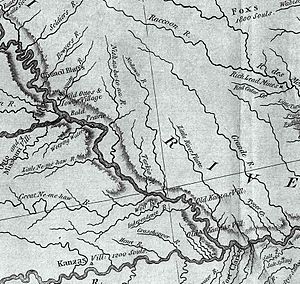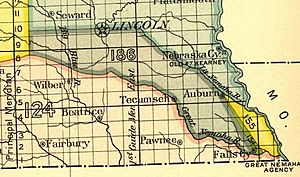Nemaha Half-Breed Reservation facts for kids
Quick facts for kids
Nemaha Half-Breed Reservation
|
|
|---|---|
| Country | United States |
| State | Nebraska |
| County | Nemaha County |
| Founded | 1830 |
| Disestablished | 1860 |
The Nemaha Half-Breed Reservation was a special area of land. It was created in 1830 by a treaty called the Fourth Treaty of Prairie du Chien. This land was set aside for people who had both Native American and European ancestors. Many of these people were children of French-Canadian fur trappers and women from tribes like the Oto, Iowa, Omaha, and Yankton and Santee Sioux.
The reservation was part of what was then called the Indian Territory. Later, it became part of the Nebraska Territory and then the state of Nebraska. Its eastern edge was the Missouri River. The land stretched west for about 16 kilometers (10 miles). To the north, it was bordered by the Little Nemaha River. To the south, it was near Falls City and the Great Nemaha River.
The reservation stopped being a legal area in 1861. People who owned plots of land there did not have to live on them. Many eventually sold their land to white settlers. Some white men even married Native women to gain control of their property. Today, a road called Half-Breed Road follows one of the original survey lines. Descendants of these mixed-heritage families still live in the area.
The Underground Railroad also passed through the Nemaha Half-Breed Reservation. This was a secret network of routes and safe houses. It helped enslaved people escape to freedom in the North. The reservation was a stop on the way to John Brown's Cave, which was about 56 kilometers (35 miles) north.
Contents
Why the Reservation Was Created
Native American tribes like the Omaha and Osage had special rules about family. Children belonged to their father's family group, called a gens. If a child's father was European, they often did not have a place in the tribe. They were seen as "white."
At the same time, European-American society often saw these children as "Native American" because of their mothers. They faced discrimination. These mixed-heritage families often felt like they didn't fully belong to either group.
To help these families, the United States government decided to set aside land for them. These areas were known as Half-Breed Tracts. The goal was to give them a place to live and own property.
The land chosen for the Nemaha Half-Breed Reservation was along the Missouri River bluffs. It was described as "too steep and tree-covered for farming." It was mostly good for hunting. The Oto, Omaha, Missouria, and other tribes agreed to the rules for this land in the 1830 Treaty of Prairie du Chien. The government set aside about 55,847 hectares (138,000 acres).
Life on the Reservation
The Nemaha Half-Breed Reservation was located between the Little and Great Nemaha rivers. By 1833, about 200 mixed-heritage people lived there.
It took many years for the government to officially organize the land. In 1854, Congress allowed the reservation to be set up. The government started a list of people who could own land there. By 1858, the list had 445 names. Each person was supposed to get about 129 hectares (320 acres).
However, many non-Native settlers, called squatters, had already moved onto almost half the land. The government did not make them leave. When the land was finally given out on September 10, 1860, each eligible person received about 127 hectares (314 acres). Louis Neal was the first person to officially own land on the reservation.
The people who owned land were never required to live on their properties. Many eventually sold their land to non-Native settlers. Today, some of the descendants of these families still live in the area. A road called Half-Breed Road follows one of the original survey lines.
Originally, the land was owned by the Otoe tribe. The government paid the Otoe $3,000 to allow the "half-breeds" from other tribes to live there. At first, the land was meant to be owned by everyone in common, like other Native American lands. But later, the US President was allowed to give individual plots to individual owners. In 1860, the government decided to give out individual plots. This was done to encourage Native Americans to live more like European-Americans. This was the first time in American history that Native Americans were given individual land plots in this way.
Towns and Important People
Barada
Barada, Nebraska is a town named after Antonine Barada. Antonine was the son of an Omaha woman and a French fur trapper. In 1856, he moved to Nebraska to settle on the new reservation land. He didn't get the official ownership of his 129 hectares (320 acres) until 1860. He became one of the first settlers in the Half-Breed Tract. Barada also ran a fur-trading post there.
The Underground Railroad is believed to have passed through this area. It went north towards John Brown's Cave, which was about 56 kilometers (35 miles) away.
St. Deroin
Indian Cave State Park is located in the middle of the Nemaha tract. On its northern edge was the town of St. Deroin. This town was founded by mixed-heritage people to serve their reservation. Joseph Deroin, whose father was a French-Canadian trapper and mother was Oto, founded it. His family had traded along the Missouri River for many years. A trading post was already there when Lewis and Clark explored the area in 1804.
Joseph Deroin ran a trading post along the river starting in 1840. He was killed in 1858 during a disagreement about money. This happened as white settlers moved into the area and pushed out Native residents. The town then became mostly European-American. Most of the town has since been washed away by floods. Only a cemetery and the St. Deroin School remain in the original spot. A stream called Half Breed Creek, named after the tract, still flows through the area.
Other important people who lived in the tract included French-Canadian fur traders who had married Native American women, like Charles Rouleau. Henry Fontenelle also had land there. He was the mixed-race son of Lucien Fontenelle, a French-American trader, and Me-um-bane, a daughter of the Omaha chief Big Elk.
End of the Reservation
Because people kept selling their individual land plots, the Nemaha Half-Breed Tract officially ended as a legal area by 1861. Today, much of the land that was once part of the reservation is now within Indian Cave State Park.



